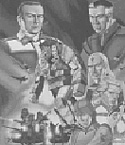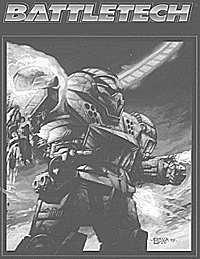 The Succession Wars: The BattleTech Grand Strategic Game
The Succession Wars: The BattleTech Grand Strategic Game
Main Designer: L. Ross Babcock III
Chicago, IL: FASA Corporation, 1987
ISBN 0-931787-72-6
2-5 players
Although the mechanics of this preferably multiplayer game are fairly simple, much of the appeal of the game is provided by its extremely colorful components, as well as the fact that it is the only grand-strategic rendering of the BattleTech universe. The map is said to represent an area about a 1,000 light-years across, and each turn is said to represent about three months.
Pages 3-4 provide one of the earlier iterations of the BattleTech future-history. Two main scenarios are provided: the Third Succession War, beginning in 3026; and the First Succession War, which begins in 2786. There are, of course, different leaders in the two scenarios, as well as some differences in combat forces and in some of the rules.
The five main powers in both scenarios are the same: House Davion (The Federated Suns); House Liao (The Capellan Confederacy); House Marik (The Free Worlds League); House Steiner (The Lyran Commonwealth); and House Kurita (The Draconis Combine). Like many SF projections, this is a highly Eurocentric future, with some Oriental input (if the leader counters and ‘Mech regiment names can be taken as a guide).
Although not represented by an actual player, ComStar, the posited mystical secret society which controls interstellar radio communications through its hyperpulse generator stations can in some circumstances serve as an equalizer or a spoiler. ComStar is an interesting addition to the BattleTech universe, and it is not difficult to see that a power that controls the flow of information between the stars might eventually become the dominant power.
There are six main types of playing pieces. There are the leaders who can enhance combat and resource collection, and are subject to bribery/blackmail by other players, except for the House Leaders. The leaders are well-illustrated, with definite character visible in their portraiture. There are the Jump Ships, which ferry leaders and troops to battle.
There are the ‘Mech regiments, who do most of the fighting, and whose crests and regimental names have been very imaginatively rendered on the counters. ‘Mech regiments are divided into the core, House regiments, and, of course, mercenary regiments that may desert and/ or switch sides, probably at the most inopportune time! There are generic regular troops. There are also markers for manufacturing-centers, which are critical in building up one’s armies and Jump Ships.
Finally, there are markers for indicating control of regions, in the five colors particular to the Houses. On the main map, the territory of each House is subdivided into about twenty regions. House Liao is markedly smaller in the Third Succession War scenario. The delineation of the Houses, it must be said, is rather abstract, and there is no attempt to coordinate it to any existing astronomical data.
Given the sci-fi genre which BattleTech represents, that’s not a problem. The names of the regions seem mostly Scottish, Russian, or Oriental-derived. However, some Tolkienian-sounding names (a tendency also seen in some of the ‘Mech regiment names) may be a little jarring.
Another important part of the map is the Technology Track. Among the player’s objectives is to increase their technological level, which allows for various enhanced combat, movement, and build abilities.
Also on the map is the box from which Event Cards are drawn, and a Discard Pile for them. There are a broad variety of possible Events, from mercenary desertion, to rises in Tech Level, to increased chances of turning enemy leaders, to combat bonuses or penalties.
Although there is the need for some revenue-collection and calculation tasks, it is kept within reasonable limits, as a typical turn revenue would be about 20 points, and they can be consumed very quickly.
All-in-all, this a highly colorful game, offering much of the flavor of the military SF genre of which BattleTech is a part. One could perhaps hope for add-on kits representing further installments of the future-history, notably, “the Invasion of the Clans”, and ComStar’s eventual bid for hegemony.
 The Succession Wars also seems like a
game that might eventually appear in an
electronic version. However, one notices
a marked tendency towards tactical
renderings in FASA’s elaboration of the
BattleTech universe, especially in terms
of combat between single ‘Mechs. The
latter can more readily be translated into
super-arcade games of either the personal
computer or virtual-reality-cubicle type,
which, it must be admitted, is probably
what most gamers are looking for today.
The Succession Wars also seems like a
game that might eventually appear in an
electronic version. However, one notices
a marked tendency towards tactical
renderings in FASA’s elaboration of the
BattleTech universe, especially in terms
of combat between single ‘Mechs. The
latter can more readily be translated into
super-arcade games of either the personal
computer or virtual-reality-cubicle type,
which, it must be admitted, is probably
what most gamers are looking for today.
Games and Books
Winter 1987/88 The Future in Gaming
FASA Corporation
ISBN: 1-55560-015-8
This catalogue of FASA products, enclosed with the copy of The Succession Wars which the author had purchased, is worthy of separate mention. However unpopular FASA may have been among some gamers, it cannot be denied that they carried out their work with a very distinctive flair. The color but fairly stark cover shows a rather gruesome looking BattleMech. The full-color back page of the catalogue has the now well-known Golden Medusas female fighter-pilot image.
The inside of the catalogue is rendered in well-differentiated black-and-white with splashes of red. The first two pages are dedicated to the TOG (Terran Overlord Government)/Renegade Legion future-history, which is definitely distinct from BattleTech, although there is a similar focus on war and struggle. The main planet-based weapon of the TOG/ Renegade Legion universe is, probably somewhat more realistically than in BattleTech, the grav tank.
The next six pages profile what are by today some of the earliest BattleTech supplements, background materials and novels. This is followed by six pages on Star Trek: The Role Playing Game.
The second last page is dedicated to Doctor Who: The Role Playing Game, while the last page advertises four games based on books by James Clavell -- Shogun, Noble House, Tai-Pan, and Whirlwind. One suspects these games did not do anywhere near as well as the books, in relation to their respective potential markets.
All-in-all, a catalogue which is one of the earlier examples of the tradition of very fine graphic standards which FASA has continuously upheld.
Back to Simulacrum Vol. 4 No. 4 Table of Contents
Back to Simulacrum List of Issues
Back to MagWeb Master Magazine List
© Copyright 2002 by Steambubble Graphics
This article appears in MagWeb (Magazine Web) on the Internet World Wide Web. Other articles from military history and related magazines are available at http://www.magweb.com